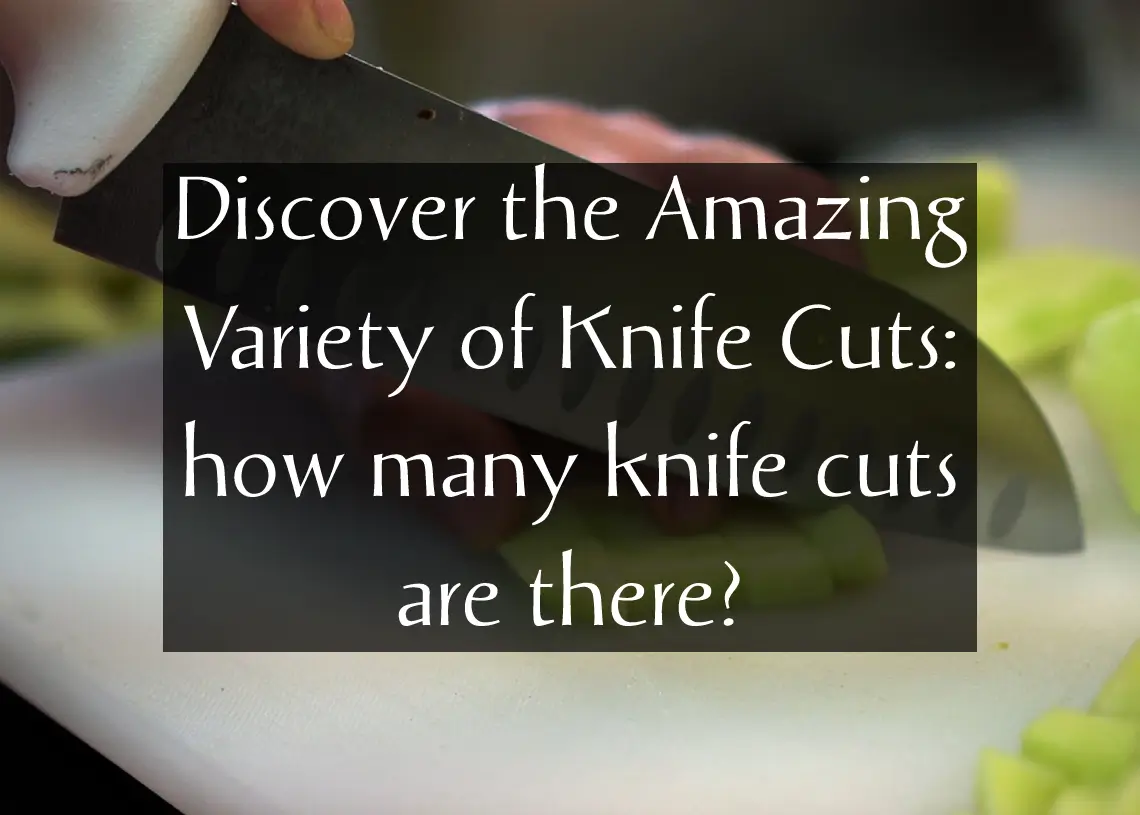Whether you’re a professional chef or just a home cook, knife cuts are essential skills that you need to master. Cutting food correctly can make all the difference in terms of texture, flavor, and presentation. The right knife cut can help make your dishes look more appetizing, and it can also help you save time and effort in the kitchen.
But how many knife cuts are there? The answer is that there are a variety of knife cuts that you can use, and each one has its own purpose and technique. In this blog, we’ll explore the different types of knife cuts and how they can be used in the kitchen. We’ll also discuss the different shapes of knife cuts and some specialized knife cuts. So let’s get started!
Introduction to Knife Cuts
Knife cuts are an important part of cooking and food preparation. They refer to the way food is cut into pieces, slices, or cubes. Knife cuts can be used to make food easier to eat, or to create decorative or artistic designs. These are also used to reduce cooking time, as they can help cook food faster.
Knife cuts can be divided into two main categories: rough and smooth. Rough knife cuts involve slicing food with a knife, while smooth knife cuts involve more precise and intricate cuts. The type of knife cut you use will depend on the type of food you are preparing and the desired end result.
Different Types of Knife Cuts
Let’s take a look at the different types of knife cuts.
Slice
The slice is one of the most basic and common knife cuts. To slice food, hold the knife in a slightly angled position and make a slicing motion. This type of knife cut is usually used for vegetables and fruits, as it creates even slices that are easy to cook.
Dice
Dicing is a type of knife cut that involves cutting food into small cubes or cubes. To dice food, hold the knife in a slightly angled position and make a cutting motion. This type of knife cut is usually used for vegetables and fruits, as it creates even cubes that are easy to cook.
Chop
Chop is a type of knife cut that involves cutting food into small cubes or cubes. To chop food, hold the knife in a slightly angled position and make a chopping motion. This type of knife cut is usually used for meats or hard vegetables, as it creates cubes or cubes that are easy to cook.
Mince
Mince is a type of knife cut that involves cutting food into small pieces. To mince food, hold the knife in a slightly angled position and make a mincing motion. This type of knife cut is usually used for herbs and spices, as it creates small pieces that are easy to cook.
Julienne
Julienne is a type of knife cut that involves cutting food into thin strips. To julienne food, hold the knife in a slightly angled position and make a julienne motion. This type of knife cut is usually used for vegetables, as it creates thin strips that are easy to cook.
How to Use Different Knife Cuts
Now that you know the different types of knife cuts, let’s take a look at how to use them.
When using a knife, make sure to use the correct grip. The correct grip will help you make precise and clean cuts, and it will also help you avoid accidents. Make sure to hold the knife with your thumb and forefinger on either side of the blade.
When cutting food, make sure to use the correct motion. For slicing, make a slicing motion, for dicing make a chopping motion, for chopping make a chopping motion, for mincing make a mincing motion, and for julienne make a julienne motion.
Make sure to use a sharp knife. A sharp knife will make it easier to make clean and precise cuts, and it will also help you avoid accidents. If you’re using a dull knife, make sure to sharpen it before using it.
Knife Cuts for Different Types of Food
Now that you know how to use different knife cuts, let’s take a look at how to use them for different types of food.
Vegetables
Vegetables can be cut into slices, cubes, strips, and thin strips. To make slices, use a slicing motion. Make cubes, use a dicing motion. Also to make strips, use a julienne motion. To make thin strips, use a julienne motion.
Fruits
Fruits can be cut into slices, cubes, and thin strips. To make slices, use a slicing motion. Make cubes, use a dicing motion. For make thin strips, use a julienne motion.
Meats
Meats can be cut into cubes, strips, and thin strips. To make cubes, use a chopping motion. Make strips, use a chopping motion. To make thin strips, use a julienne motion.
Herbs and Spices
Herbs and spices can be cut into small pieces. To make small pieces, use a mincing motion.
How to Achieve Smooth and Precise Knife Cuts
Now that you know how to use different knife cuts for different types of food, let’s take a look at how to achieve smooth and precise knife cuts.
The key to achieving smooth and precise knife cuts is to practice. Make sure to practice cutting food with different knife cuts, as this will help you become more familiar with the techniques.
When practicing knife cuts, make sure to use the correct grip and motion. Make sure to hold the knife with your thumb and forefinger on either side of the blade, and make sure to use the correct motion for each type of knife cut.
Make sure to use a sharp knife. A sharp knife will make it easier to make clean and precise cuts, and it will also help you avoid accidents. If you’re using a dull knife, make sure to sharpen it before using it.
Different Shapes of Knife Cuts
Now that you know how to achieve smooth and precise knife cuts, let’s take a look at the different shapes of knife cuts.
Knife cuts can be divided into two main categories: straight and curved. Straight knife cuts involve slicing food in a straight line, while curved knife cuts involve slicing food in a curved line.
Straight knife cuts include slices, cubes, strips, and thin strips. Curved knife cuts include crescents, ovals, and hearts.
Specialized Knife Cuts
Now that you know the different shapes of knife cuts, let’s take a look at some specialized knife cuts.
Specialized knife cuts include chiffonade, brunoise, macedoine, and julienne. Chiffonade is a technique that involves cutting herbs and greens into thin strips. Brunoise is a technique that involves cutting vegetables into small cubes. Macedoine is a technique that involves cutting vegetables into small cubes or cubes. Julienne is a technique that involves cutting vegetables into thin strips.
How Many Knife Cuts Are There?
So, how many knife cuts are there? The answer is that there are a variety of knife cuts that you can use, and each one has its own purpose and technique. Knife cuts can be divided into two main categories: rough and smooth. Rough knife cuts involve slicing food with a knife, while smooth knife cuts involve more precise and intricate cuts.
Knife cuts can also be divided into two main shapes: straight and curved. Straight knife cuts include slices, cubes, strips, and thin strips. Curved knife cuts include crescents, ovals, and hearts. There are also specialized knife cuts such as chiffonade, brunoise, macedoine, and julienne.
Conclusion
Knife cuts are an essential skill for any home cook or professional chef. Knowing how to use different knife cuts correctly can make all the difference in terms of texture, flavor, and presentation. There are a variety of knife cuts that you can use, and each one has its own purpose and technique.
Now that you know how many knife cuts are there, make sure to practice them to become more familiar with the techniques. With practice, you’ll be able to make smooth and precise knife cuts that will make your dishes look more appetizing.
Ready to discover the amazing variety of knife cuts? Try out the different types and shapes of knife cuts to create beautiful and delicious dishes.




